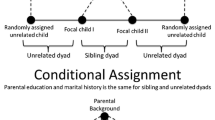Abstract
Individuals’ fertility decisions are shaped not only by their own characteristics and life course paths but also by social interaction with others. However, in practice, it is difficult to disentangle the role of social interaction from other factors, such as individual and family background variables. We measure social interaction through the cross-sibling influences on fertility. Continuous-time hazard models are estimated separately for women’s first and second births. In addition to individual socioeconomic variables, demographic variables, and an unobserved factor specific to each sibling pair, siblings’ birth events and their timing enter as time-varying covariates. We use data from longitudinal population-wide Norwegian administrative registers. The data cover more than 110,000 sibling pairs and include the siblings’ fertility, education, income, and marital histories. Our results indicate that cross-sibling influences are relatively strong for the respondents’ first births but weak for the second parity transition.
Similar content being viewed by others
References
Åberg, Y. 2003. “Social Interactions: Studies of Contextual Effects and Endogenous Processes.” Doctoral dissertation. Department of Sociology, Stockholm University.
Axinn, W.G., M.E. Clarkberg, and A. Thornton. 1994. “Family Influences on Family Size Preferences.”Demography 31: 65–79.
Bandura, A. 1977.Social Learning Theory. Englewood Cliffs: Prentice Hall.
Barber, J.S. 2000. “Intergenerational Influences on the Entry Into Parenthood: Mother’s Preferences for Family and Non-Family Behaviour.”Social Forces 77: 319–48.
Bernardi, L. 2003. “Channels of Social Influence on Reproduction.”Population Research and Policy Review 22: 427–55.
Bongaarts, J. and S.C. Watkins. 1996. “Social Interactions and Contemporary Fertility Transitions.”Population and Development Review 22: 639–82.
Cicerelli, V.G. 1995.Sibling Relationships Across the Life Span. New York: Plenum Press.
East, P.L. 1998. “Impact of Adolescent Childbearing on Families and Younger Siblings: Effects That Increase Younger Siblings’ Risk for Early Pregnancy.”Applied Developmental Science 2: 62–74.
East, P.L. and L.J. Jacobson. 2001. “The Younger Siblings of Teenage Mothers: A Follow-up of Their Pregnancy Risk.”Developmental Psychology 37: 254–64.
—. 2003. “Mothers’ Differential Treatment of Their Adolescent Childbearing and Nonchildbearing Children: Contrasts Between and Within Families.”Journal of Family Psychology 17: 384–96.
Festinger, L. 1954. “A Theory of Social Comparison Processes.”Human Relations 7: 117–40.
Haurin, R.J. and F.L. Mott. 1990. “Adolescent Sexual Activity in the Family Context: The Impact of Older Siblings.”Demography 27: 537–57.
Kohler, H.-P. 2001.Fertility and Social Interaction. New York: Oxford University Press.
Kohler, H.-P., F.C. Billari, and J. Ortega. 2002. “The Emergence of Lowest-Low Fertility in Europe During the 1990s.”Population and Development Review 28: 641–80.
Kravdal, Ø. 2001. “The High Fertility of College-Educated Women in Norway.”Demographic Research, Vol. 6, article 6: 187–216. Available online at http://www.demographic-research.org/volumes/vol5/6/5-6.pdf.
—. 2003. “The Problematic Estimation of ‘Imitation Effects’ in Multilevel Models.”Demographic Research, Vol. 9, article 2: 25–40. Available online at http://www.demographic-research.org/volumes/vol9/2/9-2.pdf.
Lamb, M.E. and B. Sutton-Smith. 1982.Sibling Relationships: Their Nature and Significance Across the Lifespan. Hillsdale, NJ: Erlbaum.
Lillard, L. and C.W.A. Panis. 2002.aML Multiprocess Multilevel Modeling v2 Reference Manual. Santa Monica, CA: EconWare.
Lutz, W., V. Skirbekk, and M.R. Testa. 2006. “The Low-Fertility Trap Hypothesis: Forces That May Lead to Further Postponement and Fewer Births in Europe.”Vienna Yearbook of Population Research 2006: 167–92.
Manski, C. 1995.Identification Problems in the Social Sciences. Cambridge, MA: Harvard University Press.
Mayer, K.U. 1986. “Structural Constraints on the Life Course.”Human Development 29: 163–70.
Montgomery, M. and J. Casterline. 1996. “Social Learning, Social Influence, and New Models of Fertility.”Population and Development Review 22: 151–75.
Powers, D.A. 2001. “Unobserved Family Effects on the Risk of Having a First Premarital Birth.”Social Science Research 30: 1–24.
Powers, D.A. 2005. “Effects of Family Structure on the Risk of First Premarital Birth in the Presence of Correlated Unmeasured Family Effects.”Social Science Research 34: 511–37.
Powers, D.A. and J. Hsueh. 1997. “Sibling Models of Socioeconomic Effects on the Timing of First Premarital Birth.”Demography 34: 493–511.
Rodgers, J.L. and D.C. Rowe. 1993. “Social Contagion and Adolescent Sexual Behaviour: A Developmental EMOSA Model.”Psychological Review 100: 479–510.
Author information
Authors and Affiliations
Corresponding author
Rights and permissions
About this article
Cite this article
Lyngstad, T.H., Prskawetz, A. Do siblings’ fertility decisions influence each other?. Demography 47, 923–934 (2010). https://doi.org/10.1007/BF03213733
Issue Date:
DOI: https://doi.org/10.1007/BF03213733




